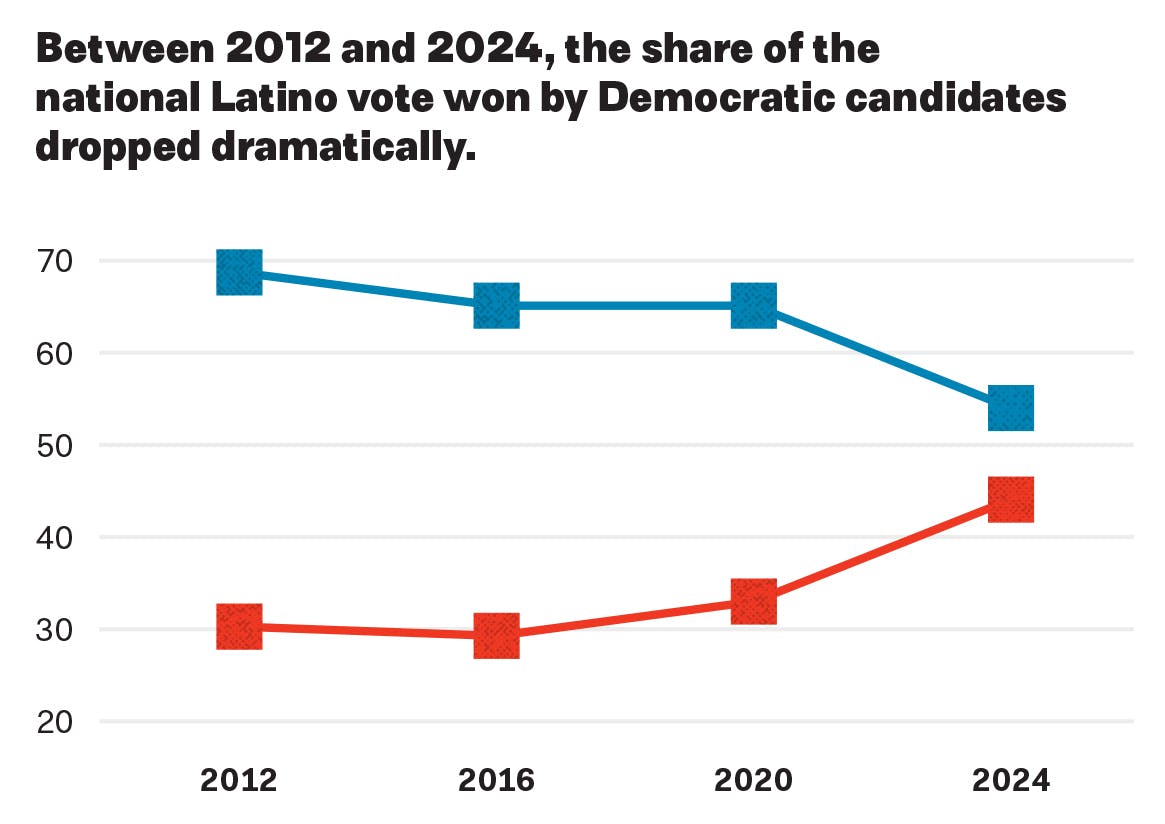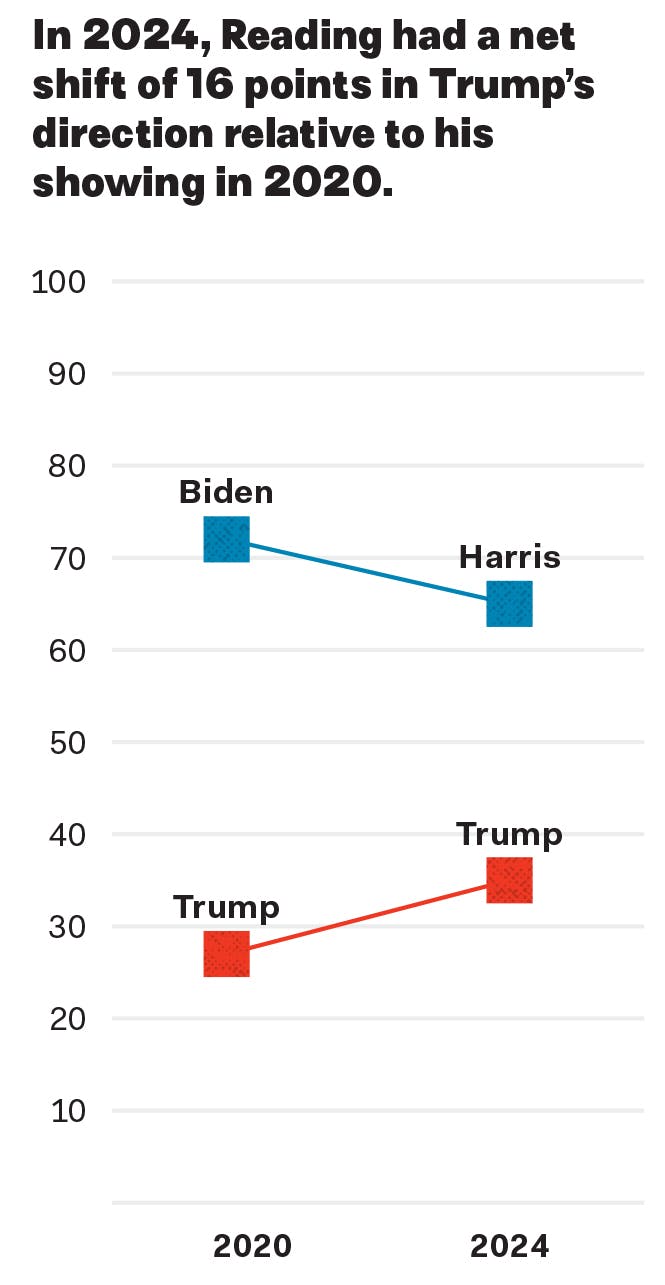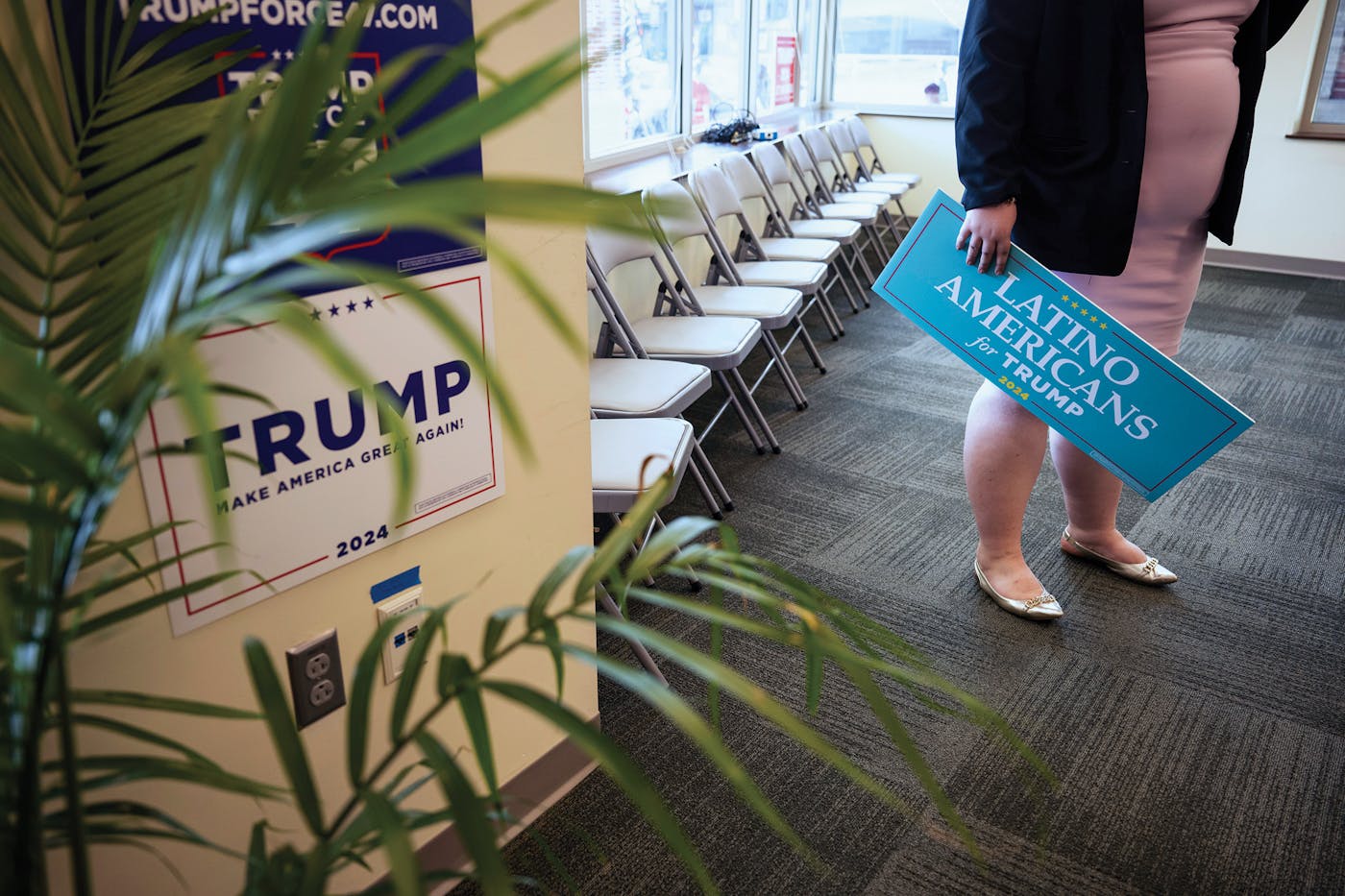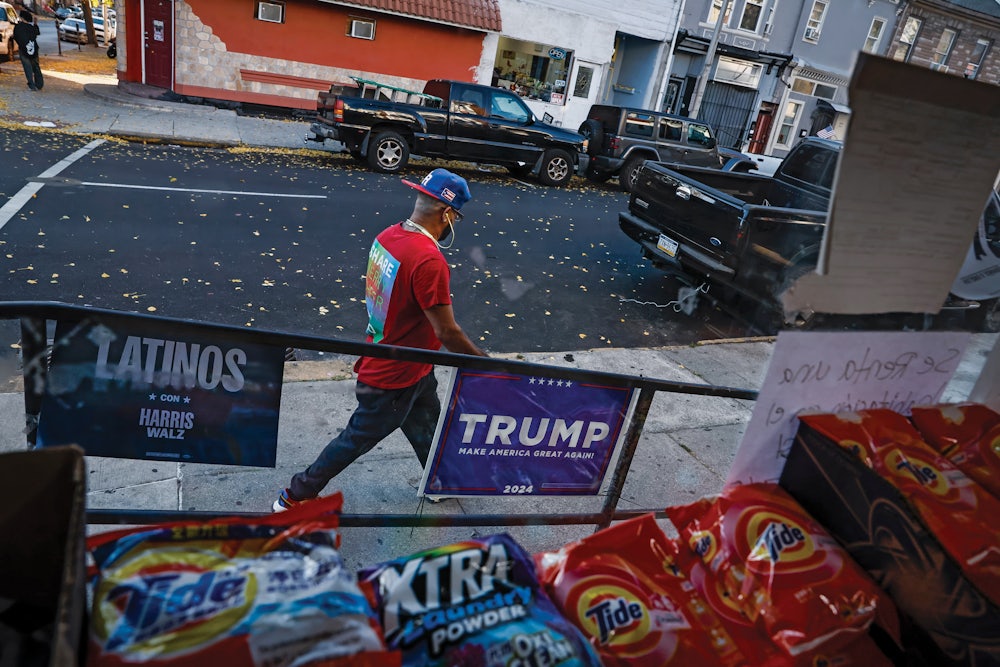During the final, frenzied week of the 2024 campaign, Donald Trump and Kamala Harris both made campaign stops in a place whose significance in the election had largely been overlooked by observers: Reading, a city of around 95,000 people nestled between the Schuylkill River and Mount Penn in central Pennsylvania.
Reading does not boast many of the noncollege-educated white voters who were widely seen as pivotal to Trump’s chances. Nor is it one of the educated, affluent suburbs or large metropolitan areas where Harris had hoped to run up the immense margins needed to lift her to victory. Yet both campaigns saw Reading as strategically critical—because this little city, which is known to most people as the nineteenth-century birthplace of the Reading Railroad, ultimately memorialized in the game Monopoly, happens to be nearly 70 percent Latino.
Trump had already shocked some Democrats in Reading by contesting it with surprising aggressiveness. He held two rallies in the small city and dispatched running mate JD Vance to campaign there twice, a remarkable commitment of time and resources to a reliably Democratic stronghold filled with nonwhite voters. What surprised Democrats was the audacity of Trump’s bet on making inroads among Reading’s Hispanics—a bet that made the city a critical test case of whether Trump’s ability to move that demographic his way was more than just a fluke of 2020 and might have more durability than many Democrats expect.
Democrats were even more surprised—and not in a good way—when the results came in.
Reading (which is pronounced “RED-ing”) had a net shift of 16 points in Trump’s direction relative to his 2020 showing against Joe Biden, according to precinct data from the election board in Berks County, where Reading is located. Harris did win Reading handily (by 65–35 percent), but Trump’s success in moving the electorate incrementally his way relative to 2020 (when Biden bested him by 72–27) helped him win the crucial Rust Belt swing state of Pennsylvania after losing it last time around.
To the dismay of local Democrats, the Reading results ended up illuminating the success of Trump’s larger winning formula, which entailed assembling an unexpectedly diverse coalition by merely shaving Democrats’ historic margins among core voter groups (without winning them outright). That includes working-class nonwhites, a demographic heavily represented in the region around Reading, which is dominated by tens of thousands of manufacturing jobs in industries like automotive batteries and food production.
“Harris won this city overwhelmingly,” Reading Mayor Eddie Morán, a Democrat who is the first Latino elected to that office in this city, told me. “But we didn’t get the percent that we needed.” As he noted, Trump operatives never expected to win the Latino vote here. Instead, they aimed to “neutralize it a little bit.”
“And that’s exactly what happened,” Morán said.
What unfolded in Reading, then, is an object lesson in what Democrats must urgently avoid going forward, if they are to prevent their coalition from fraying further and preserve their hopes of a comeback in 2026, 2028, and beyond.
Trump’s national inroads among Latinos are a terribly sobering story for Democrats. According to calculations by The New York Times’ Nate Cohn, the shift happened over the course of the last three presidential elections. After Barack Obama won Latinos by 39 points in 2012, Democrats underperformed among them in 2016. In 2020, Trump made further inroads, culminating in 2024, when Harris won the Latino vote by only 10 points. Over 12 years, that’s a staggering net shift of 29 points toward Trump among Latino voters.

Even more disconcerting, this shift unfolded even as Trump initially campaigned in 2016 by labeling Mexicans rapists and killers, and then, as president, implemented a draconian set of policies against immigrants from Central and South America, which included inflicting outright terror by way of family separations and the forcing of asylum-seekers to wait for hearings in Mexico, resulting in a variety of humanitarian horrors. Trump campaigned in 2024 on highly publicized vows of mass removals carried out with giant detention camps and the military, as well as explicit declarations that immigrants fleeing horrible civil conditions in Central and South America are “poisoning the blood” of our country—all amounting to the most openly white nationalist, anti-immigrant presidential candidacy in the modern era.
Though more data is needed to figure out what really happened here, it’s already clear that none of Trump’s anti-immigrant rhetoric or actions weighed sufficiently on the Latino voters who shifted toward him—because inflation mattered a lot more. Preelection polling by the Times showed that, for Latinos, the economy was far and away the most important issue, with immigration a distant third. A staggering 81 percent of Latino voters saw economic conditions as “poor” or “only fair.” Meanwhile, a whopping 63 percent simply did not believe that Trump’s menacing rhetoric about immigrants was aimed at them.
Indeed, in some cases, immigration might have played in Trump’s favor among Latino voters. In South Texas, for instance, many majority-Hispanic counties shifted hard toward Trump, including a number of them along the border. This suggests that, for some Latinos, border security is as important (if not more so) as how welcoming our country is toward legal immigrants, and that they blamed Harris and Biden for being overly lax on the issue while crediting Trump as “strong” on it. These claims are absurdly unfair, but they seemed to resonate, and now we need to do the work of figuring out what it all means.
To grasp how these dynamics played out in microcosm in a swing-state city, I spent a recent afternoon driving around Reading with Mayor Morán, who was born in Puerto Rico and raised in Brooklyn. A squat man with an affable demeanor that disguises a hard-edged pragmatic streak, Morán was eager to demonstrate to me just how forcefully Trump and Republicans had competed for Latinos in many neighborhoods. So we drove to King Food, a small supermarket in the lower-middle-class residential neighborhood of Glenside.
You may remember King Food. It briefly got national attention last September, when Vance did a campaign stop there. Vance held up a carton of eggs, and declared that “a dozen eggs will cost you around $4, thanks to Kamala Harris’s inflationary policies.” After internet sleuths figured out that the eggs were actually $2.99 per dozen, Vance was roundly mocked online over the incident. Some declared that it revealed what a cringe campaigner he is, and others lampooned similarly awkward moments, such as his declaration that his two sons eat 14 eggs per day.
But Morán had a very different takeaway from the incident. What nobody noticed amid all the hilarity is that King Food sits right across the street from a lower-income housing project that’s funded by city government: Glenside Homes, which is “85 percent Latino,” Morán said. As we drove past the development’s modest two-story row houses, Morán noted that Vance’s appearance was complemented by relentless campaigning among these residents by local Trump campaign operatives.
“They knocked on nearly every door here,” Morán told me.
Again and again, Morán said, he heard from residents of the development, who told him that people campaigning for Trump had engaged with them at their doors, asking: “Do you want to live better? Do you want a better economy?” For Morán, the egg-carton incident was anything but funny: What it really captured was how vigorously Trump’s campaign worked Latino neighborhoods that might typically be hostile political territory but lately were filled with people struggling with the cost of living.
Further underscoring the point, Morán recounted that Democrats did a double take when the Trump campaign opened an office right in the heart of downtown Reading, many months before Election Day. As we drove through the downtown, a mix of offices and small shops and restaurants, many Latino-owned, Morán said the Trump campaign’s bold tactics were “a huge surprise to everybody.”
Driving around Reading with Morán underscored another big takeaway: The Latino electorate is extremely diverse, even though it’s often treated in our political discourse as a monolith. Not only are many heritages represented in this small city alone—Dominicans, Puerto Ricans, Mexicans, Colombians—but the variety of life experiences is also striking and should be factored into understanding the challenges Democrats face.
For instance, Morán said, because Latinos have been arriving in Reading for decades, many residents are first- and second-generation Hispanics, some of whom work in professions like health care, the region’s second-largest industry. At the same time, many more recent arrivals are working-class, a lot of whom are drawn to the area to work in factories—Deka battery manufacturing, for instance, or the Giorgio Mushroom Co.—that are within a short drive of the city. Meanwhile, low real estate costs have attracted many other recent arrivals who have opened small businesses here, Morán told me. Among some of these people who aspire to business success, Trump’s folk appeal as a businessman-celebrity appears to resonate.
Case in point: the northeast section of Reading, which boasts the highest concentration of Latinos in the state of Pennsylvania outside Philadelphia, according to one estimate. As we drove through the neighborhood, small Latino businesses were visible everywhere: restaurants, bakeries, grocery stores, and lavandarías. It was here, Morán recounted, that he realized something was seriously amiss in the election, when signs saying PUERTO RICANS FOR TRUMP and DOMINICANS FOR TRUMP began to appear.

Among these Dominicans, Morán regularly found that any concerns about Trump’s immigration policies were outweighed by perceptions of his economic prowess. Indeed, that led some Dominicans to develop a particularly hopeful view of Trump. Some came to believe that when Trump talked about not wanting “illegals” in the country, he was really telegraphing that he might pursue some sort of amnesty for the undocumented who don’t merit removal. Amnesty, Morán said, is something they fondly associate with a Republican president, due to Ronald Reagan’s 1986 immigration reform bill. Trumpism, of course, is in many ways a direct repudiation of Reaganism’s American-exceptionalist, city-on-a-hill rhetoric about the virtues of immigration, but apparently that didn’t sink in. “A lot of Dominicans believe that could happen,” Morán told me, speaking of hopes for a Trump amnesty. “I heard that one too many times.”
Johanny Cepeda-Freytiz, the Democratic state representative whose district includes a chunk of downtown Reading, saw similar dynamics at play. Her personal story is typical of Hispanics in Reading: Her mother is Dominican, and she grew up in New York City and worked as a community organizer before moving to Reading to open a restaurant—the Mi Casa Su Casa Cafe—on Penn Street, the city’s main business strip. As I lunched on an empanada cooked by her mother in the restaurant’s kitchen, Cepeda-Freytiz told me that, as the campaign progressed, she found that many Latino small-business owners like her “were identifying with Trump as a moneymaker.”
Like Morán, Cepeda-Freytiz discovered that, because of Trump’s business celebrity, many saw him as a potential creator of opportunities. Cepeda-Freytiz saw the DOMINICANS FOR TRUMP signs and others like them, and concluded that Trump was connecting culturally in particular with Latino breadwinner men. Again and again, Cepeda-Freytiz said, she saw Latinos reacting to higher supermarket prices, only to tell her: “When Trump comes, the economy will be better.”
Trump’s planned deportations, of course, threaten to make food prices even higher. Yet Cepeda-Freytiz was dismayed to encounter some Latinos who themselves came to this country as undocumented immigrants but, now that they’re established here, see Trump as a vehicle for opportunity rather than as a threat to Latinos whose presence remains precarious. “I’m like: Wow, you forgot how you got here. You forgot where you came from,” Cepeda-Freytiz told me. “That really turned my stomach.”
It’s important to stress, as Cepeda-Freytiz and Morán both do, that many Latinos had good reason to be unhappy with the economic status quo (indeed, with the immigration status quo as well, though hoping Trump will improve the immigration system seems like a terribly misplaced bet). And they both noted that Harris still overwhelmingly won Latinos in Reading. But Trump’s inroads mattered on the margins.
To illustrate the point, Cepeda-Freytiz shared with me an analysis that local Democrats privately circulated after the election. It showed that, in raw vote totals, Harris’s support dropped by as much as 6 to 10 percentage points relative to Biden’s 2020 totals in some of the most Latino-heavy neighborhoods in Reading. “The difference went towards Trump,” Cepeda-Freytiz said, pronouncing the numbers “disturbing.”

Add up these transformations, and they help explain some bigger dynamics driving the election outcome—as well as the task ahead for Democrats. Trump won Pennsylvania by 1.7 points, and exit polls showed that, while Latinos made up only 6 percent of the vote in the state, Trump substantially improved among them over his 2020 performance. Again, the story here is all about margins. In 2024, Trump lost by 17 points among Pennsylvania Latinos, but that’s substantially down from four years ago, when he lost them to Biden by a 42-point margin. In those four years, Trump’s support among this demographic rose from 27 to 41 points, a striking shift.
Places like Reading are why this happened. Reading sits in what local operatives call “the 222 Corridor,” named for Route 222, the highway that connects Reading with other Pennsylvania cities like Allentown and Lancaster, both of which also boast sizable Latino populations. The two campaigns heavily contested this whole stretch of territory, and in part due to Latino immigration to these areas, Pennsylvania now has some 620,000 Latinos living in the state, making Trump’s successful inroads among them look even more catastrophic for Democrats.
So what should Democrats learn from all this?
Mike Madrid, a GOP pollster and critic of Trump who has studied the Latino vote for decades, has pored over postelection data and reached a precise conclusion: “Affordability,” he said, has replaced “jobs” as the key economic issue that is motivating Latino voters, and this shift in priorities favored Trump. To be sure, there is something perverse and paradoxical about the change: To a greater degree than any president in decades, Biden consciously strove to create a full-employment economy, and as the economics writer Zachary Carter explained in Slate, full employment might be Biden’s real legacy. But inflation, caused in large part by pandemic disruptions, outweighed those achievements, and even outweighed considerations of both candidates’ actual economic policy agendas.
Indeed, Madrid believes that “affordability” is becoming the touchstone for understanding some of the bigger dynamics driving what happened with the Latino vote in 2024. “The common glue with Latinos is not ethnicity, it’s not country of origin, it’s not language,” Madrid told me. “It all comes down to affordability.” He added: “Everybody has a job in this economy. What they don’t have is a job that allows you to afford living here.” Illustrating the point, Madrid conducted a postelection poll of California Latinos, and found that a whopping 65 percent of them said that “the prices we pay for everything” are “extremely important,” whereas jobs lagged behind.
Madrid believes this affordability-versus-jobs distinction is key to understanding the ongoing battle for what he calls “the new working class.” Among the political observers who have obsessed over Trump’s gains with nonwhite working-class voters, some argue that this represents a realignment. But Madrid thinks that these voters’ preoccupation with affordability actually tells a story about a Latino electorate that’s very unsettled and in flux. The Latinos who moved to Trump, Madrid said, aren’t necessarily in favor of GOP economics, but rather picked the alternative to the party that was in power while prices rose. “It’s not that they’re becoming Republican,” Madrid said. “It’s about disaffection with the Democratic Party.”
That’s also the conclusion of Camille Rivera, a political operative who worked closely with numerous Latino groups that bankrolled pro-Democratic ads in Pennsylvania. Rivera recounted that, in conversations with Latino voters in the state, she observed that they seemed to interpret Trump’s criticism of inflation on the Biden-Harris administration’s watch as a sign that he’d actually do something about costs, which they remembered being lower during Trump’s presidency. “Trump cares about our issues,” they told her.
These voters, said Rivera, were difficult to move with discussion of Trump’s actual record as president, in which the economy went into deep freeze in his last year due to the pandemic that he made much worse than it needed to be. Though Biden signed a huge Covid-19 relief package with no Republican support in 2021, arguably helping the U.S. recovery outdo that of the rest of the developed world, these voters mostly recalled the stimulus money that they received under Trump, which Democrats broadly supported. “Well, we got checks when Covid was happening,” Rivera said voters told her, in explaining why they didn’t blame 2020 on Trump.
As galling as all this is, it also suggests that we should be cautious about worrying too much that a major, permanent Latino realignment is underway. A postelection analysis by Equis Research concluded that some of the Senate GOP candidates actually underperformed Trump in some areas across the country with high concentrations of Hispanics. That includes swing states like Arizona and Pennsylvania, and even Berks County, the location of Reading. Those GOP underperformances suggest both that the results don’t necessarily represent a large-scale conversion of Latino voters into Republicans and that Trump had a unique appeal rooted partly in his signature fusion of economic and cultural celebrity.
This is an account dovetailing with the dynamics that unfolded in Reading: the identification of Trump as a celebrity moneymaker whose cultural cachet comes across to some voters as a kind of magical capacity to mitigate the struggles of small-business people; the constant focus on everyday costs of living; the belief that a change at the top, regardless of the parties’ economic policy positions, could begin to set things right.
All of this hints at a number of ways forward for Democrats.
For starters, it’s imperative not to treat the Latino electorate like a monolith or a uniform ethnic bloc. As both Morán and Madrid stressed to me, Hispanic voters are diverse in their class backgrounds and economic experiences. The second-generation Latino professional working in health care in Reading should be approached with very different messages than, say, the recently arrived immigrant who is harvesting mushrooms at the Giorgio factory just outside the city. The former might be more reachable with traditional ads addressing middle-class concerns about public order, while the latter might want such public-order reassurances but also to hear about the Democratic Party’s concrete plans to provide an immediate boost to the working class.
Similarly, the diversity of the Latino electorate can also inform how Democrats talk to Hispanic voters about immigration going forward. That second-generation Latino voter and the recently arrived immigrant factory worker might both have an interest in immigration issues, but from different perspectives. The latter might want to hear more specifics about work permits and pathways to citizenship, while more established Latinos might want to hear more about an agenda that fuses border security with a humane overall approach to handling immigration flows. Washington Monthly’s Bill Scher suggests one idea along these lines: toughening up requirements that employers refrain from hiring undocumented labor, combined with broadening numerous pathways to legal status. More such fusions should be discussed, messages that effectively integrate promises of public order with management of immigration in ways that genuinely benefit the national interest, all wrapped into one coherent vision.
Representative Greg Casar, who represents a central Texas district and was recently elected chair of the Congressional Progressive Caucus, recounted an anecdote that helps illuminate the challenge here. Earlier this year, Casar told me, he talked to a Hispanic worker in the construction trades, a registered independent, who voted for Hillary Clinton in 2016 and Joe Biden in 2020 but was planning to vote for Trump in 2024, because he’d concluded that Democrats were “focused on other stuff” and not his material concerns. When the topic turned to immigration, the worker allowed that he had relatives who lacked legal status, but he was unmoved by the fact that Republicans (including Trump) had long blocked efforts to rectify this, concluding that all that mattered is that neither party had fixed the problem.
“His response was: That’s all politics stuff, everybody is just blaming everybody else,” Casar said, and his bottom line was that “he hasn’t seen stuff get done.” So Democrats need to communicate much more effectively that they have a theory of how to actually accomplish immigration reform, either with executive actions under the next Democratic president or with the next Democratic Congress. As Casar put it, Latino working-class voters will be more open to believing the party can accomplish immigration reform if they’re persuaded up front that it is focused on their immediate material concerns, making them less vulnerable to GOP propaganda about the dangers of the other.
“The Democratic Party has always been at its most successful when working-class people know we are standing up for them,” Casar said, because it defuses Republican efforts to paint Democrats as “standing up for someone other than the everyday person.”
That lesson itself leads to several other conclusions: Democrats need to figure out how to reach Latinos with a more economically populist agenda, but also a more sustained message, which reaches them in off years as well as during election season. As Morán and Rivera told me, their conversations with Latinos in Reading revealed, again and again, that Harris’s late entry into the race left these voters largely unfamiliar with her biography, values, priorities, and intentions. The Harris campaign did pump ads about her economic plans into Latino communities, many of them emphasizing costs, but it was too late. “We have to continue to engage and better inform our community, and it has to be ongoing,” Cepeda-Freytiz told me.
Which means Democrats need to think now about how to produce a constant drumbeat of messaging in Latino communities about what specifically they will do to benefit working people, especially if and when Trump’s tariffs and his plans to dramatically slash government while giving huge tax breaks to his plutocratic allies all start to bite. Democrats should relentlessly broadcast their concrete proposals to alleviate economic suffering under Trump as it happens, years before the next election, seizing on people’s economic angst when they are primed and receptive to alternative solutions. Cultural politics will be critical here as well: Senator Ruben Gallego, who won a hard-fought race in Arizona, made special appeals to Latino men by stressing his biography as a Marine veteran who grew up in tough circumstances and held many menial jobs throughout his life. Obviously Gallego had a unique appeal for Latino men, but Democrats will need to think hard about how to replicate these displays of solidarity with working-class Latinos going forward, in a sustained and systematic way.
Yet all this underscores another problem, and it’s a deeply sobering one. It’s now clear that the Democratic Party’s undeniable deficit in the information wars, in which Republicans benefit from a massive media propaganda network while dominating more apolitical cultural information spaces, extends to Latino voters in a very big way. Casar pointed to the right-wing infiltration of Univision, the premier Latino television network, as a key turning point in these info wars. He also noted he had seen a marked uptick in right-wing propaganda via Spanish-language social media that distorts the Democratic Party’s economic plans and, tellingly, in misinformation that’s designed to turn more established Latinos against recent arrivals, dividing Latinos against one another. “Many of the voters most susceptible to right-wing disinformation are Spanish-speaking-only voters who have all sorts of propaganda dumped on them,” Casar told me. “A ton of it is in Spanish.”
How to solve the information gap with regard to Latinos is a complicated problem that will take many months or even years to figure out. For now, what’s critical is that Democrats treat this as an urgent matter that requires a comprehensive set of solutions and a real commitment of party resources. As Casar put it: “We have to make sure that folks who do not have time to get plugged into politics don’t just get covered in a right-wing-only message.”
What happened in Reading—and in many Latino-heavy communities like it—was a major wake-up call for Democrats. But it is not unfixable. As Madrid stressed, the Latino shift to Trump is real, but it may have reflected a temporary sense among many of these voters that the party previously in power was not speaking to them, rather than any newfound embrace of Republican values. And that means the Democratic Party can still repair the problem.
“The biggest challenge that Democrats face is a trust problem,” Madrid told me. “Latinos believe Democrats have solutions to their problems. But they haven’t seen any results. This is not like the past two most significant realignments, with African Americans moving toward Democrats or Dixiecrats moving to Republicans. Democrats still have a big opportunity to reconstruct a coalition around the fastest-growing group of voters in the country—if they are able to deliver.”




